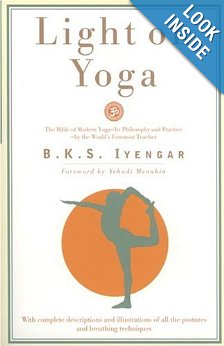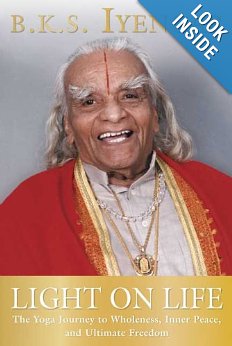 A friend recently tried a few classes at one of Vancouver’s large, multi-branch yoga studios. While her main practice is Iyengar yoga, she was curious to see what else is out there. She found teaching quality quite variable, and she was amazed at the hordes of students.
A friend recently tried a few classes at one of Vancouver’s large, multi-branch yoga studios. While her main practice is Iyengar yoga, she was curious to see what else is out there. She found teaching quality quite variable, and she was amazed at the hordes of students.
“How big are the classes?” I asked.
“At least 30, maybe 40,” she said. “And when we exit the room, the line-up for the next class is just as long!”
I wasn’t surprised. In my own explorations, I’ve attended classes with 60+ students at large studios. Considering probable attrition rates, these studios must constantly attract scads of newbies.
Iyengar yoga, despite its worldwide influence, is comparatively slow-growing. Certainly, established Iyengar yoga teachers, especially those on the workshop circuit, can draw crowds. But most local teachers rarely see 30+ students lined up for class week after week. (I’m not advocating large classes. I’m just looking at popularity, demand, and box office.)
Why doesn’t Iyengar yoga attract the masses?
A few observations:
- “Not a workout” One of my students commented that her friends wouldn’t choose Iyengar yoga because it’s “not a workout.” Nowadays yoga is considered exercise, the sweatier, the better. While Iyengar yoga is strenuous (10-minute headstands followed by a million variations!) and encompasses very demanding poses (see Light on Yoga), classes are not usually taught in a fast-paced, aerobic manner.
- Conceptual learning Iyengar yoga instruction focuses on conceptual learning. Students learn “actions” that apply to the pose being studied, to other poses, and to overall posture. Home practice is somewhat assumed. In class, a student might wish to repeat a pose (“I’m not done with it yet!”) instead of moving on. But the teacher is leading the class elsewhere–and it’s up to the student to flesh out the concept independently at home.
- Readiness I met a young woman who did Iyengar yoga six years ago and then tried a “hatha” class at her city college. Back then, she embraced the freer, less-strict approach and even completed a yoga teacher-training program at the college. Recently, however, she began to appreciate her former Iyengar yoga teacher’s words–and she’s back to studying Iyengar yoga. One must be “ready” for the discipline of this method.
- Time commitment Iyengar yoga classes are typically 1.5 to 2 hours long. Drop-ins are allowed, but eventually commitment (to a series/session) is expected. Sessions are akin to those in school: 10 to 14 weeks long, which might seem like forever to casual students who prefer random attendance in a variety of classes.
 Money commitment Paying for a per-class series/session inevitably costs more than for a pass allowing “unlimited” classes. If attending three or more classes weekly (class = practice), it’s very economical to buy an unlimited monthly pass for $100. Such passes are atypical in Iyengar yoga.
Money commitment Paying for a per-class series/session inevitably costs more than for a pass allowing “unlimited” classes. If attending three or more classes weekly (class = practice), it’s very economical to buy an unlimited monthly pass for $100. Such passes are atypical in Iyengar yoga.- Luxurious setting For some, a luxurious spa setting, including such amenities as saunas and lounges, is appealing. In contrast, I’ve seen fantastically airy, spacious Iyengar yoga studios, but nothing resembling a spa. (Note: My formative yoga experience, which I loved, took place in an unheated basketball court at the UC Berkeley rec centre. While that’s too bare-bones for me now, I might always prefer simpler spaces.)
- Demographics I know I’m generalizing, but at large studios, most students are youngish and relatively fit. In contrast, a typical Iyengar yoga class includes a wider range of fitness levels and ages. Does the average 20-something seek the company of other 20-somethings? Do they flock to particular venues because their peers do? I know teens who once accompanied Mom to Iyengar yoga classes, but switch to hot yoga to join their friends.
- Levels Is Iyengar yoga “hard” or “easy”? (Egads, such divergent opinions!) Actually, Iyengar yoga can go either way: Teachers can safely accommodate (and make yoga “easier” for) those with limits–and rigorously guide (and make poses “harder” for) those with agile bodies. If people understand how individualized the Iyengar approach is, there might be fewer misconceptions.
- “Spiritual vibe” Some teachers read quotes and talk “yoga talk”–and those craving a “spiritual vibe” just lap it up! They probably won’t find such a vibe in Iyengar yoga classes, which might initially seem “technical” and not very spiritual. Especially in beginner classes, teachers generally don’t discuss the sutras or philosophy; they also don’t say things like “melt your heart” or “you are beautiful.” Students have to stick around to discover real spirituality.
For Iyengar yoga to attract the masses, must it change? Maybe. Should it?
Once, I had a student who regularly attended my classes for a year. She then thanked me, but admitted that she missed “flow” yoga. My first reaction: I could have taught her class more dynamic sequences; after all, in my own practice I do sun salutations almost daily! But I later concluded that I should never teach according to what students want. I must teach what’s best for them. In her case, occasional flowing sequences were appropriate, but she needed to work on fundamentals at least half the time.
Likewise, any change to the Iyengar method should be done because it’s effective, not because it’s a selling point.
Leave a Comment